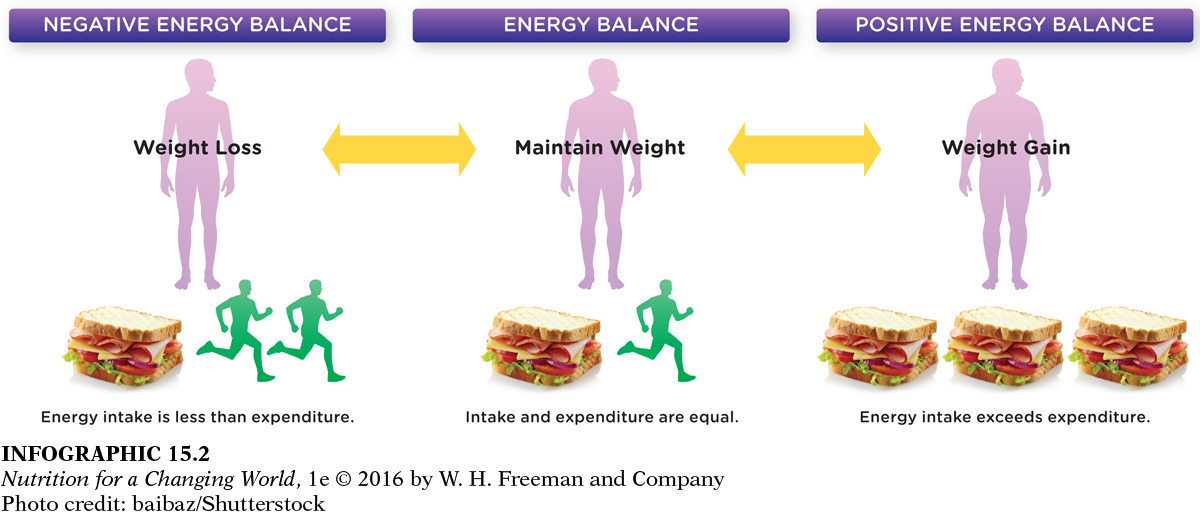ENERGY IN, ENERGY OUT
To understand our obesity crisis, says Levine, you have to realize that it didn’t happen overnight. “Obesity doesn’t occur over minutes and hours,” says Levine. “Obesity occurs over years, decades, and generations.”
What that means is that even small changes in the way we eat or the way we move can seriously add up. Even something as simple as an extra spoonful or two at each meal or the amount of time we spend sitting or standing—
ENERGY the capacity to do work
Energy, defined as the capacity to do work, is required to perform all the various functions that are necessary to sustain life, from breathing to moving to digesting food to maintaining a constant body temperature. Humans and other animals obtain energy through the breakdown of carbohydrates, fats, proteins, and alcohol in food and beverages. The energy contained in the chemical bonds of these molecules is released by the chemical reactions of metabolism and captured in a form that can be used to do the body’s work. (To learn more about the cell’s energy supply, see Chapter 16.)
CALORIE a unit of measure defined as the energy required to raise 1 g of water 1°C
One way scientists measure energy is in units called calories. A calorie is defined as the energy required to raise 1 g of water 1°C. The energy in food is commonly measured in units of kilocalories (1,000 calories). A kilocalorie (kcal) is the energy required to raise 1 kg of water 1°C. All food labels in the United States report the energy in foods in kilocalories, although these are usually just written as “calories.”
Obesity results from a chronic imbalance of energy intake and expenditure. According to the laws of thermodynamics, energy is neither created nor destroyed but merely changes form. This principle, known as the conservation of energy, means that when we consume more energy than we expend, the excess has to go somewhere. Most often, it goes to our hips, thighs, and bellies as fat.
POSITIVE ENERGY BALANCE the state when energy intake exceeds energy expenditure that leads to weight gain
NEGATIVE ENERGY BALANCE the state when energy intake is less than energy expenditure, resulting in weight loss
To be in energy balance means that the amount of energy we take in (“energy in”) equals the amount of energy we use (“energy out”). When this occurs, our body weight is stable. Any increase in our body weight indicates that “energy in” is greater than “energy out.” Fundamentally, the only way to gain weight is to consume calories in excess of what is expended (positive energy balance), and the only way to lose weight is to consume fewer calories than expended (negative energy balance). Obesity results from chronic positive energy balance. (INFOGRAPHIC 15.2)
Question 15.2
 What are two strategies to avoid or reverse weight gain?
What are two strategies to avoid or reverse weight gain?
To avoid or reverse weight gain, increase energy expenditure or decrease energy intake.
This discussion reveals something unique about energy nutrients compared with other nutrients: body weight provides us with an easily monitored indicator of adequacy, excess, or insufficiency.
Just why is having excess body fat bad for you? Scientists used to explain the negative consequences of obesity in terms of the added strain put on a person’s heart, lungs, and other organs. But that’s no longer thought to be the primary problem. Although it is true that some problems, such as sleep apnea, can result from being physically large, most of the negative health consequences of obesity are believed to stem from the biochemical effects of fat in our bodies. Fat is not just a blob of inert yellow goop hanging out in our bodies; rather, it’s dynamic tissue with an active life all its own. It secretes an abundance of different hormones that exert effects on other tissues in the body. These hormones cause a low-

Question 15.3
 What directly stimulates the development of the low-
What directly stimulates the development of the low-
Fat cells produce hormones and hormone-
